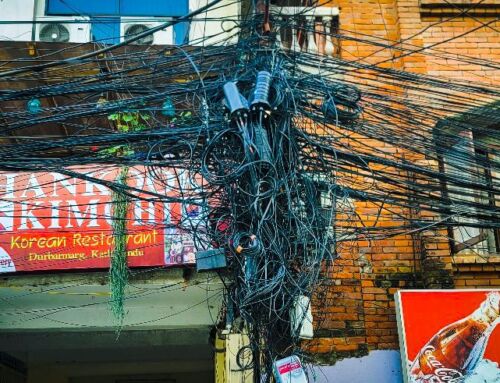View by Topic
Recent Articles
-
New Environmental Laws from the 2024 Maryland Legislative SessionSaturday, April 27th, 2024
-
EPA Designates PFOA and PFOS as Hazardous Substances under Superfund LawSaturday, April 20th, 2024
-
Federal Government Finalizes New Efficiency Standards for LightbulbsSaturday, April 13th, 2024
-
2024 IECC is Final After Addressing Preemption IssuesSaturday, April 6th, 2024
-
Settlement Portends Broad Failure in Attempts to Ban Natural GasSaturday, March 30th, 2024
View by Month/Year
“Green Building Law Update” Headlines
Recent Articles & News from
Stuart Kaplow’s blog
at GreenBuildingLawUpdate.com
- EPA Takes Action: PFOA and PFOS Now Hazardous Substances Under Superfund Law April 21, 2024
- Shedding Light on the Future: The Evolution of Lightbulbs in the Wake of New Energy Efficiency Standards April 14, 2024
- 2024 International Energy Conservation Code is Final After Addressing Preemption April 7, 2024
- Settlement Portends Broad Failure in Attempts to Ban Natural Gas March 31, 2024
Subscribe to the Green Building Law Update!
Stuart Kaplow brings his expertise and extensive experience to the table with his unique digital publication, "Green Building Law Update". Subscribers receive regular updates to keep them informed about important issues surrounding Environmental Law, Green Building & Real Estate Law, as well as the emerging demand for Environmental Social Governance (ESG).
Get fresh content through the lense of Stuart Kaplow's cutting-edge expertise, innovative commentary and insider perspective. Don't miss another issue! Subscribe below.

Maryland Building Energy Performance Standards Effective January 1
On January 29, 2024, after this article was posted, the Maryland legislature’s Joint Committee on Administrative, Executive, and Legislative Review (AELR) put a “hold” on the proposed regulations to create the Maryland Building Energy Performance Standards (BEPS) as required by the Climate Solutions Now Act of 2022.
The regulations require covered building owners to measure and report data to the Maryland Department of the Environment. The regulation further requires that covered building owners reduce net direct GHG emissions and energy use intensity (EUI) measurements.
The regulations were published in the December 15, 2023 issue of the Maryland Register.
The primary function of AELR is to review proposed regulations to determine whether they conform to the statutory authority of the unit and the legislative intent of the statute under which the regulations are proposed. The hold letter as transmitted from the AELR to the Maryland Governor and MDE provided the committee wanted to look into the economic impact the regulations may have.
The hold is effective for renewing 30 day periods until released by AELR. There is an alternative for an override by the Governor. We will post here when more information is available.
This post includes preliminary comments on the Maryland Building Energy Performance Standards regulations proposed to be published on December 15, 2023.
This follows our post last week alerting commercial real estate owners and tenants in those buildings in Maryland about these regulations requiring Greenhouse Gas Data Must be Collected Beginning January 1 in Maryland.
There is much that could be commented on, however in the interest of efficacy in clearly communicating our concern about the complete and utter failure of the regulations to implement the Climate Solutions Now Act of 2022, moreover, that the regulatory scheme described is all but entirely constitutionally barred as preempted by the federal Energy Policy and Conservation Act, without providing for any meaningful reduction in GHG emissions, risk irreparably harm the Maryland economy, we offer only a dozen comments:
1. That the schedule for these regulations, prescribed in statute, has been missed (.. by more than half a year) is more than simply a little problematic for the real estate industry which thrives on certainty. To state the obvious, these regulations are only proposed to be published on December 15, 2023, and will not be final until, at best, months hence, after building owners are mandated to begin collecting GHG data on January 1, 2024, using methodologies proposed in those regulations. The prolonged uncertainty in implementing this sweeping program, with regulations that will be more than half a year late, is untenable to those regulated. The hard dates for businesses to act as prescribed in the statute must be moved back, realistically by not less than 2 years.
2. In section 26.28.02.B.(10), the definition of the Benchmarking tool as the sole method to measure and report data as Portfolio Manager is problematic for several reasons although, without more information from MDE (even with the release of the draft TM 23-01 Technical Guidance and Calculations Methodologies document), it is not possible to comment completely. At a minimum, there should be more than one way to measure GHG emissions when the overarching goal of this effort is to reduce GHG emissions. Additionally, if a building actually reduces its GHG emissions by 20% in advance of January 1, 2030, such should be in compliance with the law irrespective of some Energy Star score (that may or may not reflect any reduction in GHG emissions). If the expectation is that all covered buildings will have an Energy Star score of 80 or better by January 1, 2030, such is not what the statute contemplates and is simply not practicable (e.g., an older structure in Baltimore City with an Energy Star score of 47 today, will never be able to reasonably achieve these targets, greatly disadvantaging the states older urban areas and their populations, while putting a finger on the scale in favor of Montgomery County with its newer taller suburban structures and affluent demographics).
Moreover, Energy Star scores are a moving target that increases over time, which is not something the statute permits. The use of Energy Star as other than a voluntary scoring tool presents very real concerns about who owns the GHG emission data, including matters of confidentiality (see more on this below). Finally, as noted this benchmarking was not the purpose Energy Star was created for, so with the regulations devoid of a definition of “net zero net direct greenhouse gas emissions” will some Energy Star data extrapolations make that determination for buildings in Maryland?
3. The regulation of Energy Use Intensity is not authorized by the statute. And of great import, this text in the regulations about EUI does not reduce net direct GHG emissions for covered buildings; what this whole body of law is about. Additionally, MDE’s choice to regulate “site” EUI as opposed to “source” EUI is simply wrong if, again, the overarching goal is reducing GHG emissions, because Maryland is and will be a net importer of electricity (.. so, as proposed, this entire new regulation of EUI burdens Maryland covered building owners, but does nothing about the emissions from an electric generating plant in Tennessee that supplies Maryland buildings?).
Best left for another day is that the building activity site energy targets are crazy low and cannot stand. For example, compare the normative primary energy target to those in ASHRAE Standard 100 and see what a national standard describes as reasonable and still resulting in reduced energy consumption.
Most significantly, the statute simply does not authorize a penalty for failure to achieve an EUI “target” (.. that is, EUI is expressed only as a target versus other jurisdictions that have BEPS that regulate EUI but not GHG emissions). Overreaching to regulate how much electricity is used in a building is also regressive ignoring the embedded carbon in the built environment benefiting a building that stands empty, or for the fewest hours per week, and is not utilized to its maximum efficiency. (A Maryland county library official has articulated that the only way for his libraries to meet the requirement will be to operate fewer days and fewer hours each week.) But the real externality of this regulatory scheme will be to select winners that will be modern suburban buildings (.. think Montgomery County) and losers that will be older urban adaptive reuses (.. think Baltimore City).
Particularly disconcerting is that this proposed regulating of EUI is that it is the worst form of apocalyptic environmentalism, with MDE articulating that unless covered building owners drastically reduce consumption, humankind with its growing numbers and appetite will overwhelm the planet’s ecosystems.
4. In section 26.28.02.C., the requirement for “third party verification” of benchmarking reports is described, in part, and then referencing the Technical Guidance, is too narrowly defined including limiting that work to be done by engineers. Today, the federal government including other programs in EPA allows a broad breadth of professionals, and across the country, it may be attorneys at law who most often provide that type of verification (e.g., opinions of counsel on green bonds [including for Maryland state issued sustainability bonds] on Fannie Mae green project mortgages, etc.); and accountants provide that third party verification in SEC matters and the like. The regulations should be broad including that attorneys, accountants, and others, who are already doing this work in the GHG space, can and should be authorized to provide those verifications in Maryland.
5. That the proposed regulations are devoid of the statute’s Environment Article, section 2-1602, required “special provisions or exceptions” including for buildings where the commercial tenant installed, owns, and is responsible for the building energy systems. This is not a matter of environmental efficacy but rather does not reflect an understanding of how many covered buildings are owned and operated. This is a major void.
The regulation is anti ingenuity and rejects innovation when it does not include a provision, as required by the statute for allowances for the use of biofuels, does not provide for fuel cells, makes no provision for hydrogen power generation, does not touch on building carbon capture or for that matter any technology based solution.
6. Concomitantly, Environment Article, section 2-1602 could be expanded to address residential condominiums (.. today, the statute only allows a dispensation for buildings with “commercial tenants”) where the law burdens the building owner, but where the building energy systems as well as cooking, hot water and laundry appliances are almost always owned and controlled by individual unit owners.
7. The regulations do not include variance or waiver provisions and not only would such ameliorate the harsh effects of the law but could provide real and good alternative compliance paths as well as altered schedules to achieving Maryland’s ultimate net zero goals. Most similar building energy regulatory schemes across the country, including the model ordinance provided on the website of the consultant engaged by Maryland, include a variance process.
8. The regulations do not provide for compliance by way of offsets. Offsets will be key for many buildings to be able to achieve net zero. Both the White House’s new proposed definition of zero emission building and LEED Carbon Zero allow for offsets. By way of example, offsets through Maryland based organics recycling facilities including food waste based compost would allow Maryland businesses to do more to reduce their GHG and provide for flexibility in meeting the State’s requirements while allowing for ease in auditing. Of course, reducing food waste is another of the several of the aims of SB 528 of 2022, not only from the perspective that it is the single most common material landfilled in the U.S. but also results in more than 14% of total U.S. methane emissions and more than 8% of anthropogenic GHG emissions, offering an opportunity for meaningful reductions (including that is a major recommendation of COP28 just completed in Dubai). The statute identifies pursuing organics recycling facilities, and offsets associated with using organics recycling, including food waste contributed to nutrient rich soil amendment and compost should be provided for in these regulations.
9. Maybe most significantly of all of these comments, the regulations do not address who owns the GHG emissions data the State now demands be calculated, collected, and publicly reported, but worse the regulations pervert existing precepts of privacy and confidentiality provided for by federal and state law. The statute only provides,
“(D) ELECTRIC COMPANIES AND GAS COMPANIES SHALL PROVIDE ENERGY DATA, INCLUDING WHOLE–BUILDING AND AGGREGATE DATA, TO THE OWNERS OF COVERED BUILDINGS FOR BENCHMARKING PURPOSES.”
.. which verbiage in and of itself arguably does no harm, but does not attempt at allocating responsibility and costs between owners and occupiers of buildings when both are necessary participants to comply with this new body of law that only regulates ‘owners’. But then these regulations add section 26.28.02.02.04.A.
“(7) For covered buildings with fewer than five tenants, electric ..”
.. differentiating building occupancies and creating a bar for landlords from obtaining the required data from many tenants (including those with leases and renewal terms that stretch for years). If there is any one issue that must be addressed, this is it. Matters of accuracy, transparency, and incentives are key considerations for ensuring that this data is effectively used to address the challenges of climate change. Today, organizations must mitigate the risk associated with keeping their own data safe and this regulation must address that, but it does not. And all of that is before the dollar costs to landlords now being charged by tenants for providing that data and likewise.
10. Section 02.02.04.B(5), excluding electric vehicle charging from benchmarking is not authorized by statute and will not only result in a jaundice report (i.e., electric truck charging stations are huge users of electricity and more). If MDE desires to pick winners and losers in forms of transportation so be it, but don’t fudge the numbers on the energy truthfully and factually used at some buildings, but not others (e.g., that makes Portfolio Manger data less than reliable). The legislature chose to protect first floor restaurants, but it did not choose to protect electric vehicle charging. This should be deleted.
Similarly, backup power is a life safety issue mandated by building codes as well as a business necessity (from nursing homes to police stations, and highrise residential structures, etc.), especially as the grid becomes less reliable. Stand by and backup generators should be exempt from this regulation.
11. The entire new subsection 02.05. requiring disclosures before a contract of sale is entered into for a covered building is inappropriate, not authorized by statute, and could only negatively alienate the sale of real estate across the state. There is no similar requirement in Maryland law promulgated by regulation and not authorized by statute. And requiring a buyer’s signature on the addendum simply does not reflect the reality of how contacts are entered into, and real estate transferred. This provision must be deleted.
12. Chapter 04. Alternative Compliance and Special Provisions describe an alternative compliance pathway that is an excessive fine imposed and not what the legislature contemplated. When the General Assembly enacted SB 528 in April 2022, the social cost of C02 as estimated by the EPA was $51 a metric ton. Politics in Washington DC being what it is, as a result of a change of the party in the White House, the social cost of ‘greenhouse gas’ is now estimated at between $180 and $230 a metric ton; so to use that larger measurement (i.e., GHG versus C02) and higher dollar (not $51 but $230) and to add an annual CPI escalation is not what the legislature enacted, and is not supported by facts.
The penultimate observation must be that the regulations risk causing irreparable harm to the Maryland economy (where nearly 90% of businesses are located in a covered building) without providing for any meaningful reduction in GHG emissions. That is, these regulations propose only to capture “net direct GHG emissions” from covered buildings which are a subset of all Scope 1 GHG emissions, that are less than 10% of a building’s total GHG emissions (Scope 2 and 3 account for more than 90%) and the entire building sector may represent less than 29% of all GHG emissions with these ‘covered’ buildings being a subset of maybe 12% of all private Maryland buildings, exempting most government buildings including schools; so not much in the way of GHG emissions are being reduced.
In conclusion, in the statute that is the Climate Solutions Now Act of 2022, the General Assembly found that “the State has the ingenuity to reduce the threat of global warming and make greenhouse gas reductions a part of the State’s future ..,” but these regulations do the opposite, and attempt to impose apocalyptic environmentalism on the State. Such is the polar opposite of what the legislature believed in making a techno optimism finding that ingenuity and science, properly applied, can help produce our way out of our predicament. These proposed regulations contradict the idea of employing ingenuity in the important work of reducing GHG emissions.
Maryland has enacted the most rigorous state law in the country reducing GHG emissions and otherwise addressing climate change. The real estate industry can and should treat this as the greatest responsibility and opportunity of our time. But for such to be successful, substantial revisions to the proposed regulations are necessary and proper, including the ideas expressed above.
As the January 1, 2024 date approaches and thereafter, for Maryland building owners to commence tracking GHG emissions, we are available to assist on these matters including providing turn key professional services.
Join us for a live webinar “GHG Data Must be Collected For Buildings Beginning January 1st in Maryland” 30 talking points in 30 minutes, Tuesday, December 19 at 9 am EDT presented by Stuart Kaplow and Nancy Hudes on behalf of ESG Legal Solutions, LLC. The webinar is complimentary, but you must register here.









